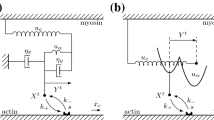Abstract
Based on the framework of sliding-filament theory and on the cross-bridges dynamics, a mathematical model for the simulation of the force response and length change of individual myofibril is presented. The myofibril is modeled as a group of segments placed in series, each segment represents a half-sarcomere with active and elastic properties. A multiple-state cross-bridge formalism relates the half Sarcomere force to the chemical kinetics of ATP hydrolysis. The corresponding system of nonlinear nonlocal partial differential equations of the model is analyzed. A numerical approach is introduced and some numerical tests are performed. The proposed in-silico model enables the study of biologically relevant process in the muscle contraction process, also in the case of muscular diseases, with reasonable computational effort.








Similar content being viewed by others
References
Blinks JR, Rudel R, Taylor SR (1978) Calcium transients in isolated amphibian skeletal muscle fibers: detection with aequorin. J Physiol 277:291–323
Campbell KS (2009) Interactions between connected half-sarcomeres produce emergent mechanical behavior in a mathematical model of muscle. PLoS Comput Biol 5(11):e1000560
Campbell SG, Hatfield PC, Campbell KS (2011) A mathematical model of muscle containing heterogeneous half-sarcomeres exhibits residual force enhancement. PLoS Comput Biol 7(9):e1002156
Capelo A, Comincioli V, Minelli R, Poggesi C, Reggiani C, Ricciardi L (1981) Study and parameters identification of a rheological model for excised quiescent cardiac muscle. J Biomech 14:1–11
Colli PL (1986) A mathematical model of heterogeneous behavior of single muscle fibres. J Math Biol 24:103–118
Colli P, Comincioli V, Naldi G, Torelli A (1988) Some mathematical and computational aspects of muscle contraction. In: Eisenfeld J, Levine DS (eds) IMACS Transactions on Scientific Computing, 12th IMACS World Congress, Biomedical Modelling and Simulation. J.C. Baltzer AG, Scientific Publishing Co. Basel, pp 159–161
Colli P, Comincioli V, Naldi G, Reggiani C (1988) Mathematical modelling for contracting muscle. In: Ricciardi LM (ed) Biomathematics and related computational problems. Kluwer Academic Publishers, Dordrecht, pp 603–613
Colli P, Comincioli V, Naldi G, Torelli A (1990) A mathematical study of the plasticity effects in muscle contraction. Appl Math Optim 22(1):1–26
Comincioli V, Naldi G (1990) Mathematical models in muscle contraction: parallelism in the numerical approach. Math Comput Model 13(1):109–115
Comincioli V, Torelli A (1983) Mathematical aspects of the cross-bridge mechanism in muscle contraction. Nonlinear Anal 7(6):661–683
Comincioli V, Torelli A (1988) A mathematical model of contracting muscle with viscoelastic elements. SIAM J Math Anal 19:593–612
Comincioli V, Torelli A (1988) A mathematical study of a continuum-state cross-bridge model of muscle contraction. Math Methods Appl Sci 10(3):289–302
Comincioli V, Torelli A, Poggesi C, Reggiani C (1984) A four-state cross bridge model for muscle contraction. Mathematical study and validation. J Math Biol 20(3):277–304
Edman KAP, Reggiani C (1984) Redistribution of sarcomere length during isometric contraction of frog muscle fibres and its relation to tension creep. J Physiol 351:169–198
Edman KAP, Reggiani C (1985) Differences in maximum velocity of shortening along single muscle fibres of the frog. J Physiol 365:147–163
Edman KAP, Reggiani C (1987) The sarcomere length tension relation determined in short segment of intact muscle fibres of the frog. J Physiol 385:709–732
Eisenberg E, Hill TL (1978) A cross-bridge model of muscle contraction. Prog Biophys Mol Biol 33:55–82
Eisenberg E, Hill TL, Chen YD (1980) Cross-bridge model of muscle contraction: quantitative analysis. Biophys J 29:195–227
Givli S (2010) Towards multi-scale modeling of muscle fibers with sarcomere non-uniformities. J Theor Biol 264:882–892
Glantz AS (1977) A three-element description for muscle with viscoelastic passive elements. J Miomech 10:5–20
Hill TL (1974) Theoretical formalism for the sliding filament model of contraction of striated muscle Part I. Prog Biophys Mol Biol 28:267–340
Hill TL (1975) Theoretical formalism for the sliding filament model of contraction of striated muscle Part II. Prog Biophys Mol Biol 29:105–159
Huxley AF (1957) Muscle structure and theories of contraction. Prog Biophys Biophys Chem 7:255–318
Huxley AF, Simmons RM (1971) Proposed mechanism of force generation in striated muscle. Nature 233:533–538
Julian FJ, Sollins KR, Sollins MR (1974) A model for the transient and steady-state mechanical behaviour of contracting muscle. Biophys J 14:546–562
Mirsky I, Parmley WW (1974) Evaluation of passive elastic stiffness for left ventricle and isoIated heart muscle. In: Mirsky I, Ghista DM, Sandier H (eds) Mechanics cardiac. Wiley, New York
Naldi G (1988) Multiple actin sites models of muscle contraction. Mathematical study. Pub. IAN N. 600, Pavia
Robertson SP, Johnson JD, Potter JD (1981) The time-course of \(\text{ Ca}^{2+}\) exchange with calmodulin, troponin, parvalbumin and myosin in response to transient increases in \(\text{ Ca}^{2+}\). Biophys J 34:559–569
Schappacher-Tilp G, Leonard T, Desch G, Herzog W (2015) A novel three-filament model of force generation in eccentric contraction of skeletal muscles. PLoS ONE 10(3):e0117634
Silverthorn DU, Johnson BR, Ober WC, Ober CE, Silverthorn AC (2016) Human physiology: an integrated approach. Pearson, San Francisco
Smart DR (1974) Fixed point theorems. Cambridge University Press, Cambridge
Torelli A (1997) Study of a mathematical model for muscle contraction with deformable elements. Rend Sem Mat Univ Poi Torino 55(3):241–271
Acknowledgements
This study was partially funded by ADAMSS (ADvanced Applied Mathematical and Statistical Sciences) Center of the Università degli studi di Milano.
Author information
Authors and Affiliations
Corresponding author
Ethics declarations
Conflict of interest
The author declares that he has no conflict of interest.
Rights and permissions
About this article
Cite this article
Naldi, G. A chemo-mechanical model for the single myofibril in striated muscle contraction. Meccanica 52, 3357–3369 (2017). https://doi.org/10.1007/s11012-017-0654-9
Received:
Accepted:
Published:
Issue Date:
DOI: https://doi.org/10.1007/s11012-017-0654-9




